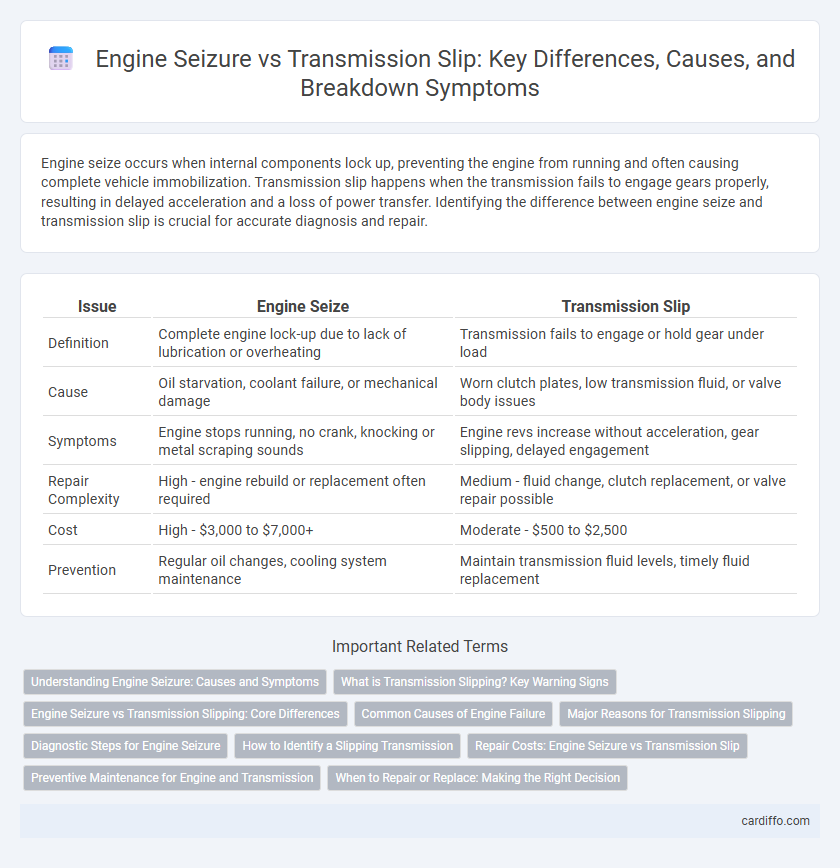Engine seize occurs when internal components lock up, preventing the engine from running and often causing complete vehicle immobilization. Transmission slip happens when the transmission fails to engage gears properly, resulting in delayed acceleration and a loss of power transfer. Identifying the difference between engine seize and transmission slip is crucial for accurate diagnosis and repair.
Table of Comparison
| Issue | Engine Seize | Transmission Slip |
|---|---|---|
| Definition | Complete engine lock-up due to lack of lubrication or overheating | Transmission fails to engage or hold gear under load |
| Cause | Oil starvation, coolant failure, or mechanical damage | Worn clutch plates, low transmission fluid, or valve body issues |
| Symptoms | Engine stops running, no crank, knocking or metal scraping sounds | Engine revs increase without acceleration, gear slipping, delayed engagement |
| Repair Complexity | High - engine rebuild or replacement often required | Medium - fluid change, clutch replacement, or valve repair possible |
| Cost | High - $3,000 to $7,000+ | Moderate - $500 to $2,500 |
| Prevention | Regular oil changes, cooling system maintenance | Maintain transmission fluid levels, timely fluid replacement |
Understanding Engine Seizure: Causes and Symptoms
Engine seizure occurs when internal components, such as pistons and cylinders, overheat and fuse together, often due to insufficient lubrication or coolant failure. Symptoms include sudden loss of power, loud knocking noises, and inability to restart the engine. Differentiating engine seizure from transmission slip is critical, as the former affects engine rotation, while transmission slip involves gear engagement issues without engine stalling.
What is Transmission Slipping? Key Warning Signs
Transmission slipping occurs when the vehicle's transmission fails to engage properly, causing a loss of power transfer from the engine to the wheels. Key warning signs include delayed acceleration, erratic gear shifts, a noticeable increase in engine RPM without a corresponding increase in speed, and unusual noises such as whining or clunking from the transmission. Ignoring these symptoms can lead to severe damage and costly repairs.
Engine Seizure vs Transmission Slipping: Core Differences
Engine seizure occurs when internal engine components lock due to lack of lubrication or overheating, causing the engine to stop functioning abruptly. Transmission slipping involves the transmission's gears failing to engage properly, often indicated by delayed acceleration or strange noises. While engine seizure results in complete engine shutdown, transmission slipping leads to impaired power transfer without immediately stopping the engine.
Common Causes of Engine Failure
Engine seizure often results from inadequate lubrication, overheating, or severe mechanical wear, which causes internal components to fuse and halt function. Insufficient oil levels, coolant leaks, and clogged oil filters frequently trigger overheating and engine damage. Transmission slip typically arises from worn clutch plates, low transmission fluid, or faulty solenoids, but does not directly cause engine failure.
Major Reasons for Transmission Slipping
Transmission slipping occurs primarily due to worn or damaged clutch plates, low transmission fluid levels, and faulty torque converters. Overheating caused by contaminated or old transmission fluid leads to loss of hydraulic pressure, reducing the transmission's ability to engage gears properly. Additionally, internal component wear such as damaged gears, bands, and seals contributes significantly to transmission slippage and eventual failure.
Diagnostic Steps for Engine Seizure
Engine seizure diagnosis begins with inspecting the engine oil for proper level and contamination, as lack of lubrication often causes seizure. Next, checking for mechanical damage such as scored cylinders or broken piston rings through compression testing helps identify internal failure. Finally, assessing the timing belt or chain condition and verifying cooling system functionality ensures the engine is not overheating, which can lead to seizure.
How to Identify a Slipping Transmission
A slipping transmission can be identified by delayed acceleration despite pressing the gas pedal, erratic shifting between gears, and a noticeable burning smell from the transmission fluid. Checking the transmission fluid's color and level is crucial; burnt or dark fluid often signals internal damage. Listening for unusual noises like whining or clunking during gear changes also helps differentiate transmission slip from engine seize.
Repair Costs: Engine Seizure vs Transmission Slip
Engine seizure repair costs typically run significantly higher due to extensive internal damage often requiring a full engine rebuild or replacement, ranging from $3,000 to $7,000. Transmission slip repairs, generally caused by worn clutches or fluid issues, usually cost between $1,000 and $3,500 depending on the transmission type and severity. Accurate diagnosis is critical to prevent escalating expenses as engine repairs tend to be more labor-intensive and parts-costly than transmission fixes.
Preventive Maintenance for Engine and Transmission
Engine seize results from inadequate lubrication or overheating, causing internal components to fuse and halt operation, while transmission slip occurs when the gearbox fails to engage properly due to worn clutches or fluid issues. Preventive maintenance for the engine includes regular oil changes, coolant checks, and timely inspection of belts and filters to ensure optimal performance and avoid catastrophic failure. For the transmission, maintaining proper fluid levels, periodic fluid replacement, and monitoring clutch condition are essential to prevent slippage and extend transmission lifespan.
When to Repair or Replace: Making the Right Decision
Engine seize typically demands immediate repair or replacement due to catastrophic internal damage, often indicated by sudden loss of power and abnormal engine noises. Transmission slip, characterized by delayed acceleration or gear shifting issues, may warrant repair if caught early but often leads to replacement when internal components are severely worn. Evaluating repair costs against vehicle value and examining diagnostic fault codes help determine the most cost-effective solution.
engine seize vs transmission slip Infographic

 cardiffo.com
cardiffo.com